#he’s the last ruler of Rome’s Republican era
Text
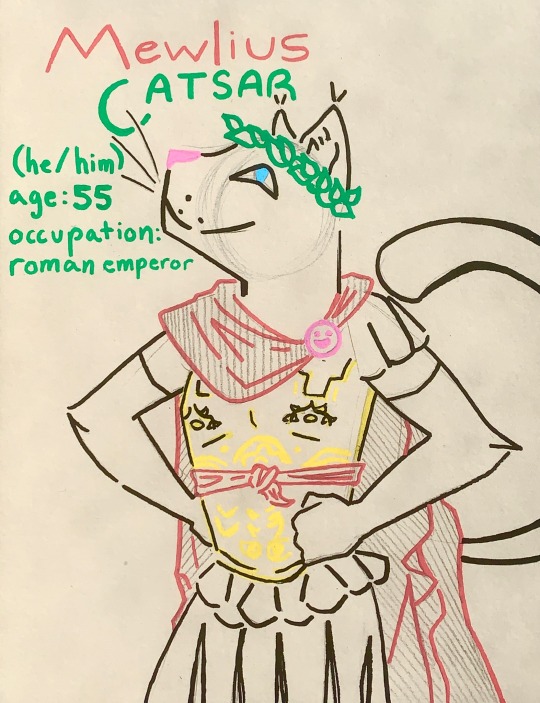
oh boy I sure hope nothing bad ever happens to my new OC Mewlius Catsar I just love my little boy so much even if he is consolidating his power in a way that grows worrisome

also here’s his bestie (and maybe even potential love interest???) Marcanine Wufius Booftus! relationship lore to come, but suffice to say, Catsar knows that Booftus will always have his back
#he was never actually an emperor#he’s the last ruler of Rome’s Republican era#my bad thanks @luenkel for catching that#myart#oc#oc art#furry#furry art#anthro#anthro art#traditional art#cartoon#updates to come#ides of march#julius caesar#brutus#caesar#rome#ancient rome#i’m sorry
110 notes
·
View notes
Text
Greece: A historical essay - Part 1/4
On the 25th of March 2021, the people of Greece celebrate their independence day. This year is especially important because it is exactly 200 years since the outbreak of the revolution (1821). I decided to honor my country and its history with a (relatively) detailed post.
Most people around the world already have knowledge regarding ancient Greece, so I will be brief here.
ANCIENT AND ARCHAIC GREECE:
between 3000 and 1100 B.C. roughly, there existed the Minoan civilization of Crete. We know little about them besides their elaborate palaces (anaktora), intricate plumbing systems and wonderful frescoes. They used the linear A in their writing, which remains undeciphered to this day. This civilization was one which traded with the outside world. Being an island, they also did not have many fortifications, which might have contributed to their downfall. There are 2 main theories as to their decline: Invasions from the mainland Mycenaeans or the major volcanic eruption of Santorini around that time.




Pictured above: 1) a partially destroyed room, allowing a peek inside 2) some restored frescoes 3) an outer room 4) A showcase of the simple and geometric, yet elaborate and colorful, structure of the building. All of these pictures are from the Palace of Knossos.
The next civilization to succeed them were the aforementioned Mycenaeans, who thrived between 1650 and 1200 B.C. They originally lived in the Peloponnese peninsula, on the southern tips of mainland Greece. It appears that they invaded and subjugated the Minoans at some point. They used linear B for their alphabet, which has successfully been deciphered and is our first indication of archaic or proto-Greek. The later tales of Homer (Odyssey and Iliad) are set in the 1200s and involve Mycenaean legendary heroes and rulers.
They were organized in independent and semi-independent city-state kingdoms, crafted bronze weapons and were a war-like people. Around 1200, we see an increase in fortifications around their settlements and the remains of their palaces carry signs of having been burned. This implies that they, too, fell to an invading force which had been threatening them.
The Minoans and Mycenaeans appear to have both used a centralized “manorial” or palatial economic system, which revolved around their grand palaces.
After their fall came the dark age of ancient Greece, which lasted from 1100 to 750 B.C. As implied by the name, we have very little information about this time. Pottery lost its elaborate design and became merely geometric, the linear B alphabet stopped being used, settlements were much smaller and fewer in population.
One other notable involvement is the arrival of the Doric tribes to the Greek mainland, displacing and possibly mixing with the Mycenaeans.
CLASSICAL GREECE:
This is the ancient Greece everyone knows and loves. The Dorians were not the only ethnic group of that time, with them appeared the Ionians, Achaeans, and Aeolians. In myth, these are all relatives who came from the same ancestor, Hellen (not the famous Helen of Troy, but instead a male patriarch from Thessaly).
The Achaeans might have had a relation to the Myceneans or have existed alongside them to some degree, This is only a hypothesis though.
The Dorians were the direct ancestors of the Spartans and Corinthians, among other smaller states of the Peloponnese.
The Ionians are best remembered as the ancestors of the the Athenians but also their many coastal and islander allies, including the region of Ionia (modern Smyrna/Izmir region) in Asia Minor.
The Aeolians lived in modern-day Thessaly and were the most numerous of the Greek groups. During the Doric invasion, some of them fled to the island of Lesbos and the region of Aeolis (which they named) in Asia Minor.
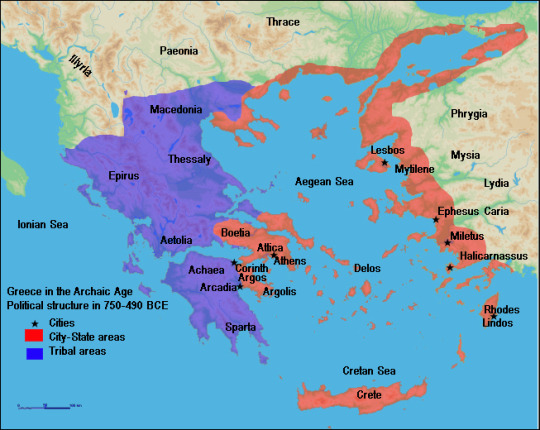
During this period we see the early foundations of what would evolve into the ancient Greek city-state model, as most imagine it, as well as the government forms of Classical Greece - Oligarchy, Democracy, Tyranny. These forms of government acted as ancient ideologies of sorts, to a degree.
In Sparta, Lycurgus implemented the reforms which led to the highly militarized, disciplined, regimented and isolationist Spartans of the Classical period.
In Athens, there was a succession of reformers who led to the establishment of Democracy. First was Dracon, the least democratic of all and whose laws give us the modern definition of the word “Draconic”, afterwards we have the moderate Solon, who can be credited with the foundations of Democracy and maintaining a balance between the aristocratic wealthy and the common poor. There was a brief interruption to democracy between 561 - 510 B.C. as the leader of the Democratic faction, Peisistratus, took the reins of power as a Tyrant (back then, the word had a neutral or even slightly positive connotation, along the lines of “benevolent dictator/enlightened autocrat). The laws and customs of Athenian Democracy were kept in place during those years and were able to blossom after the end of the tyranny. Cleisthenes was the next in the line of reformers. A radical democrat, he greatly expanded the power of the poorer citizens. All of these reforms led directly to the Athenian Democracy inherited by Pericles right before the Peloponnesian war and during the zenith of Athenian power, wealth and culture through its leadership of the Delian League.
Before that though, there were the Persian wars, which started when the coastal city-states and former colonies of Asia Minor cried for help to the Greek mainland, in an effort to avoid complete annexation by the Persian empire.
This led Greece to band together against the threat of the Persians and beat them back, after many losses and much hardship. This is considered the main grand epoch of the classical era and bound them all together as “Hellenes” for the first time.
Greece was not a place of long-lasting peace and alliances though. Soon after, the Athenian populist democratic politicians promised their people great opulence, which they could only ensure by taking from the common fund of the Delian League and using that money on their city. Thus Athens prospered at the expense of its supposed allies, leading to the era of Athenian Hegemony around the 5th century B.C. (Sparta used to be the hegemon before them, around 650 B.C.). This all lead directly to the Peloponnesian war of 431 - 404, where the Spartans emerged victorious after protracted campaigns and battles, gaining the title of “liberators” for dismantling the Athenian hegemony and liberating their tributaries.
During this period we also have the beginning of Greek philosophy as we know it, with the activity of Socrates. Pre-Socratic philosophers were generally natural scientists and cosmologists, he was the first to deal with moral and political philosophy, changing the term forever. Plato was his student, who famously wrote his own political system in “The republic” and unsuccessfully tried to implement it in Syracuse. Aristotle was the student of Plato and became the founder of Mixed government and Classical republicanism (as it was later known and developed later in the renaissance), he was also the teacher of Alexander the Great, the famous Greek-Macedonian king who created an empire.
Sparta’s attempt at aiding oligarchic tyranny in Athens, with the conclusion of the war, failed and Athens returned back, somewhat weak but still great, after only a few years. The next hegemon to take the title were the Thebans, the third most powerful city-state of the era. They held it for a short while in the 3rd century, until Alexander the Great’s father, Philip II, took that title from them, laying the groundwork for the later conquests of his son.
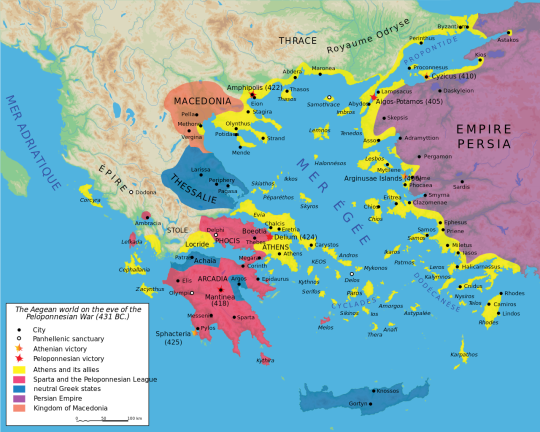
Alexander defeated the Persians, conquered Egypt, Babylon, Asia minor, Persia itself and finally modern-day Pakistan and Afghanistan, reaching the Indus river, where he finally met his equal at the hands an Indian kingdom and was forced to return back to Babylon, where he died.
His empire fractured into four successor states and Rome met little resistance, fighting only Epirus and a weakened Macedon, in their conquest of Greece.
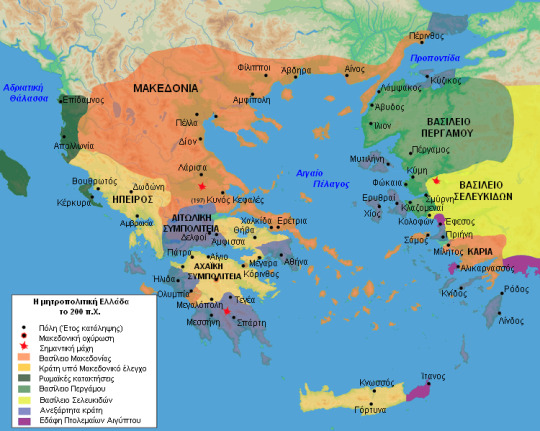
Pictured above: Greek states around 200 B.C.
Bright yellow: Seleucids
other Yellow: Achaean League, Epirus and states under Macedonian influence
Dark Blue: Aetolian League and Independent states
Orange: Macedon
Dark Green: early Roman conquests
Light Green: Kingdom of Pergamum
Purple: Ptolemaic (Egyptian) holdings
11 notes
·
View notes
Photo

Tudors, the Masters of Propaganda: When the Pen is Mightier than the Sword
The biggest winners of royal history because as far as European dynasties go are the Tudors. Let’s face it. There’s been no dynasty or group more successful in rewriting and shaping the modern world as the Tudor clan.
“The story of our past is open to interpretation. Much of British history is edited and a deceitful account of events … The sooner you do a little digging, you discover it is a tapestry of different stories, woven together by whoever is in power at the time.” (Lucy Worsley in “British History’s Biggest Figs)
^This! How we see history is in accordance to our politics. Her first episode focuses on deconstructing the wars of the roses, presenting the facts and the different accounts that have come up of the men and women involved in this conflict, leaving the viewer to decide what might have likely happened.
In regards to the Princes, in other pages I administer, some have said that it would be good to have the bodies that were found in the Tower of London examined to find once and for all who ordered their deaths. But assuming that the crown allows for DNA testing, allowing the world to finally know if they are the Princes in the Tower or not, supposing they are, it wouldn’t provide us with an answer.
Like with Richard III, science would tell us how they died -and offer us an accurate description (based on facial reconstruction) on how they looked- but it wouldn’t tell us who kill them.
Unless we were to discover a letter of Richard, Margaret Beaufort or any other suspect, declaring their guilt, the Princes in the Tower will remain one of history’s greatest cold cases.
What is undeniable though is that the Tudors were crafty in making the people believe that they were chosen by God to rule over England. There were prophecies by the Welsh, made up ancestry, and of course a wedding that was promoted as the union between Lancaster and York that would put an end to the war and bring forth a dynasty that would last forever.
“The line between fact and fiction often gets blurred.” (Lucy Worsley in “British History’s Biggest Figs)
It’s true. Often fiction becomes the new history. Most of the times, it is because we have great storytellers who give us a simpler version that isn’t too complicated or convoluted, that it is easier for us to accept.
The wars of a roses a turbulent period but it wasn’t chaotic. People were tired of civil war, and it might be one of the reasons why they were ready, after Henry VII put many rebellions down, to accept their new overlords.
Not only that but fast-forward to the sixteenth century when religious tensions were at an all-time high, when there was divisions among Catholics and even Protestants, the Tudors were more desperate than ever to solidify their power. Henry VIII needed a son to secure a dynasty that many abroad still questioned its legitimacy, while also a tool to make themselves immortal. Henry VIII wasn’t a fan of Protestantism but he liked the idea of Kings being above reproach, subject to no judgment but God’s. Kings were no longer half-divine, in Henry’s mind, English Kings were now completely divine. What their conscience wanted is what God wanted. Going against the King was no longer treason but a sin as well.
When Edward VI succeeded his father, his coronation pageant included many religious symbolism, primarily figures of the Old Testament like Josiah and Moses. These powerful visuals were meant to tell the people that their new King was God’s messenger on Earth and that he would turn England into an Evangelical nation.
Then there is Mary I. Mary was seen as the great Catholic hope and to some extent she was but she soon proved that she her father’s daughter. And like her father she was determined to be the sole sovereign of her nation. She engaged in theatrics as her mother had done, playing the part of the dutiful wife to her Spanish husband, Prince Philip, King of Naples and Sicily, begging him not to leave, writing to him constantly about how much she needed him. But once he was with her, she proved that she was more like her Tudor ancestors than their Spanish ones. Mary was also compared to religious figures. These matronly figures helped her justify her reign before her subjects who weren’t used to the idea of female monarchy.
When her friend, cousin and Archbishop of Canterbury, Reginald Pole, advised her to return Church lands to the Church, she pretended not to listen. Those lands had benefited many powerful subjects she didn’t wish to antagonize, not to mention that some of those lands were now in possession of the crown. Would Mary really give them all up after all the revenue they had provided her family? The answer is obviously ‘no’.
When she confronted the rebels that were led by Wyatt, she inspected the troops as a King would, and gave a rousing speech, where she said that she was a mother protecting her children from harm, and that she would be ruled by her people rather than by her needs.
Mary ended up pardoning many of the rebels but had no mercy for most of their leaders. At the end of her reign despite her efforts to cleanse the Catholic Church in England of corruption and restore a Humanist curriculum in the universities, as well as re-funding some of them; Mary suffered from Protestant propaganda and her own failure which was not giving the kingdom an heir to continue the Tudor line and her religious ambitions.
As soon as Elizabeth I got her sister’s reign, she quoted one of the psalms where she said that “this is the Lord’s doing” and “it is marvelous in our eyes”. Curiously, it is recorded that when she said this, she was next to a royal oak, similar to what her ancestress, Elizabeth Woodville, when she reputedly encountered the Yorkinst King for the first time.
As always, another Tudor monarch who employed great rhetoric, and used biblical and classical symbols to justify her reign. As she got older, she continued to dress extravagantly. While many people expected her to marry, she chose to remain a Virgin.
Nobody knows the full extent of her relationship with her male favorites but given how strict she was with her ladies, it is safe to say that her religiosity wouldn’t have allowed her to be intimate with them.
While supporting many Protestant groups overseas, she was quick to dismiss them when they preached about a Republican government. Elizabeth didn’t like this because that meant that the King was no longer close to God, but another public servant who was under strict scrutiny by his people.
In various paintings, one can see Elizabeth being led to victory by classical goddesses, being given the sacred fruit. She is their chosen one, the one who will vanquish all of England’s enemies and is closer to God than anyone else.
Using her single status, she became a substitute for the Virgin Mary. One whose virtue was no longer mocked but praised.
But, in spite of this, Elizabeth I was also a pragmatist and as previously stated, when she found that some of her councilors were leaning towards more radical branches of Protestantism, she confronted them and fought them hard using her best tool: her words. Turning them against one another, and foiling their plans to institute Evangelical measures.
When she died, she was hailed as one of the greatest. This is largely due to nostalgia. James VI of Scotland succeeded her becoming James I of England. He and his wife, Queen Anne were jointly crowned on Westminster Abbey. Despite James’ efforts to be a good ruler, people grew disappointed of him and soon began to look towards the past, transforming it into a place of beauty and mysticism. Despite some writers looking down on Catholic Margaret Beaufort and her son Henry VII, and his granddaughter Mary I, they made figures like Henry VIII and Elizabeth I into national icons. Henry VIII’s split from Rome and Elizabeth I’s defeat of the Armada became legend.
What they wrote endured for centuries. Some will argue that it endures today, with many people still buying into the myths that these figures wrote about their reigns, proving that nothing is more powerful than propaganda. The pen is truly mightier than the sword.
Recommended reading: Tudor by Leanda de Lisle; Wars of the Roses: Fall of the Plantagenets and the Rise of the Tudors by Dan Jones; Armada by Garrett Mattingly, Elizabeth I: The Struggle for the Throne by David Starkey, Henry VII by SB Chrimes, Plantagenet Chronicles by Derek Wilson; Mary Tudor: Princess, Bastard, Queen & The Queen’s Bed: An Intimate History of Elizabeth’s Court by Anna Whitelock; Blood Sisters & Game of Queens by Sarah Gristwood; The Myth of Bloody Mary & Tudors vs Stewarts by Linda Porter; Inside the Tudor Court by Lauren Mackay; The Anne Boleyn Collection by Claire Ridgway; In Bed With the Tudors & Elizabeth of York & The Six Wives and the Many Mistresses of Henry VIII by Amy Licence; Blood will tell by Kyra Cornelius Kramer; Margaret Beaufort by Elizabeth Norton; The King’s Mother by Elizabeth Norton; 1536: The Year that changed Henry VIII by Suzannah Lipscomb; Private Lives of the Tudors by Tracy Borman; The Woodvilles by Susan Higginbotham; The Wives of Henry VIII & Mary, Queen of Scots by Antonia Fraser.In terms of documentary, there is the source quoted which comes from the first episode of the new documentary series “British History Biggest’ Fibs” presented by Lucy Worsley.I also recommend her six wives documentary which is currently being shown on PBS every Sunday on the US; Suzannah Lipscomb and Dan Jones’ documentary on the six wives and David Starkey’s documentary on them as well. They also have other documentaries that also focus on the wars of the roses and the Tudor era. Bits and pieces of some of these can be found on YouTube, while others you have to buy or watch if you have subscription on Netflix or Hulu.
42 notes
·
View notes
Text
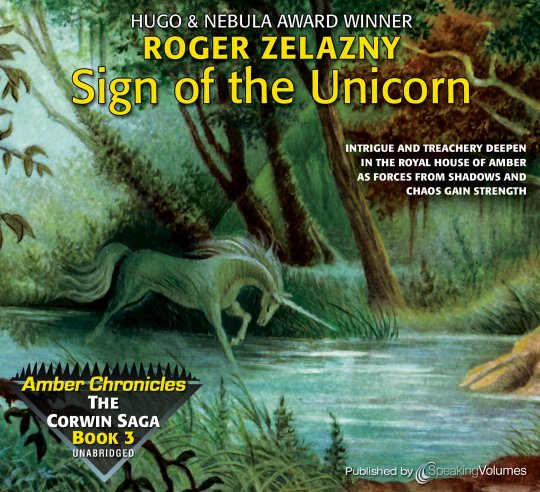
THE CHRONICLES OF AMBER & History Lessons II
The first two books of Roger Zelazny’s Chronicles of Amber — Nine Princes in Amber and The Guns of Avalon — were written between 1967 and the early 1970s. The Vietnam War cast a long shadow from the 1960s into the first years of the next decade. In Nine Princes in Amber, for example, one of the most memorable episodes of action and conflict occurs in the seventh chapter:
“The sheets of light and heat flapped a steady, welling thunder as we ran, and the waves of warmth beat upon us, washed over us. Soon they were right there alongside us, and the trees blackened and the leaves flaked down, and some of the smaller trees began to sway. For as far ahead as we could see, our way was an alley of fires… We made it to the fork, though, beating out flames on our smoldering clothing, wiping ashes from our eyes… We ran through burning grasses… The interlocked branches of the trees overhead had become as the beams in a cathedral of fire…”
The Vietnam War was part of the nightly news back then. Stories and images of napalm and agent orange falling upon the jungles of Southeast Asia were current at the time and the quote above would have resonated in the American consciousness. But it was not just the horrors of war haunting America. There was also civil unrest and a rebellious younger generation ready to take up arms against the old guard who had nourished the conflicts and tensions leading to the strife stretching from the ’60s into the ’70s.
After the baptism of fire experienced by narrator and main character Corwin — which concludes with the provident arrival of riflemen trained and led by him to defend Amber and position him as the kingdom’s effective ruler — he finds himself at the top of a society struggling with an uneasy and temporary peace. Powerful foes have been unleashed upon the immortal city, and it looks like it may have been an inside job. In fact, it may even be that Corwin himself has provided unintended assistance to the enemy. This self-reflective attitude of examining one’s own role in the evils plaguing the world belonged very much to the troubling era which began with the assassination of President Kennedy and ended with the resignation of President Nixon.

SIGN OF THE UNICORN (1975)
History: The longest gap between the publication of any of the books of The Chronicles of Amber: three years. An air of defeat hangs over America, as well as over places beyond. The Club of Rome puts out its report “The Limits to Growth” and in 1974 the world population reaches four billion. The Apollo 13 failure of 1970 has left its mark, followed by a decline in support for the program dooming the final three missions to cancellation. Apollo 17 therefore sees the last men on the Moon in December of 1972, when one of the most popular photographs ever is taken — the iconic “Blue Marble” image of a nearly full Earth — and soon becomes an emblem of the environmental movement. In contrast to the “Blue Marble,” in the summer of ’72 the Pulitzer Prize-winning “Napalm girl” photograph makes headlines, and less than a year later the last U.S. soldier leaves Vietnam subsequent to the Paris Peace Accords. The war is over and the U.S. did not win it.
The war may be over, but deep problems remain — a description of the years during which Zelazny wrote Sign of the Unicorn, but also a description of the contents of the book itself. “The Troubles” — as the conflict in Northern Ireland comes to be called — of the United Kingdom undergo a rapid escalation: the British Army shoots dead 14 unarmed marchers on terrible Bloody Sunday; the British embassy in Dublin is burned down during rioting all over Ireland; bombs detonate in Whitehall and the Old Bailey; car bombs set by the Ulster Volunteer Force in Dublin and Monaghan kill 33 civilians and injure 300 others.
Meanwhile, a story just as big unfolds on the other side of the Atlantic: Five White House operatives are arrested for the burglary of the Democratic National Committee offices at the Watergate Hotel. Nixon orders special prosecutor Archibald Cox to be fired over his subpoena of recordings of incriminating White House conversations, but is eventually compelled by the Supreme Court to release the tapes. Impeachment proceedings underway, the public and even members of the Republican Party against him, Nixon resigns in August of 1974 and the unelected Vice President, Gerald Ford, becomes President. Likewise, Eric falls and Corwin steps in as the interim regent of an Amber reeling from war and internal strife, a state of affairs closely matching the condition of America as offered in Nixon’s resignation speech.
Lesson: Corwin finds himself the target of an attempt to frame him for the murder of Caine, his brother Gérard pummels him in a fight and dangles him over a cliff, he is nearly stabbed to death in his suite only hours after Brand is knifed in similar fashion, in the misty city of ghosts known as Tir-na Nog’th he is attacked and comes perilously close to plummeting to his death. In this context, the cautions of his sister Fiona regarding the dangers of wearing for too long the ultimate artifact of power, the Jewel of Judgment, take on new meaning. She warns it can kill him. The information possibly saves his life, as it persuades him to remove the Jewel when at the brink of death. The lesson is bigger than that, however. Corwin learns that power without knowledge or wisdom is dangerous and can be fatal, something which his brother Eric, as king, did not discover in time.
Journey: It all begins with Corwin’s discovery of a crime and a corpse, which leads straight to his learning of Random’s attempt to rescue Brand from his tower. And it ends with Corwin and Random, along with Ganelon, looking down upon the damaged Pattern (also the result of a crime, though they do not know that yet), just a day after Corwin’s meeting with a freshly rescued and recovered Brand. Crimes call out for investigation and from the first pages of the first book Corwin has played the detective. In the opening scene, Corwin has questions for Random and in the final scene he finally has some answers. Now he knows from his interview with Brand that there was a conspiracy by the red-haired faction to seize Amber’s throne, that Dara is descended from Chaos and intended for that throne, that a game has been in progress where he has been but a useful knight and where the broken Pattern before him is the board upon which it has been played.

Watergate, Painful Endings...
...and Perhaps Resurrections — the Mid-’70s
“The sun was that great orb of molten gold we had seen earlier. The sky was a deeper blue than that of Amber, and there were no clouds in it. That sea was a matching blue, unspecked by sail or island. I saw no birds, and I heard no sounds other than our own. An enormous silence lay upon this place, this day. In the bowl of my suddenly clear vision, the Pattern at last achieved its disposition upon the surface below. I thought at first that it was inscribed in the rock, but as we drew nearer I saw that it was contained within it—gold-pink swirls, like veining in an exotic marble, natural-seeming despite the obvious purpose to the design… A dark, rough-edged smudge had obliterated an area of the section immediately beneath us, running from its outer rim to the center.”
Dark times are depicted in Sign of the Unicorn amidst the darkest days of the Seventies. OPEC launches its oil embargo, soon doubling the price of crude, all just after the dollar has been devalued 10%. A recession affecting most of the world ensues, and the oil crisis does not wind down until 1974. Cults, destructive to themselves and often to others, appear in newspapers and on television. The Manson Family is sentenced, the Symbionese Liberation Army abducts and brainwashes heiress Patty Hearst, the Heaven’s Gate UFO cult is founded near San Diego.
Violent groups on the radical left, however, are increasingly foiled and contained: the Baader-Meinhof Red Army Faction is arrested; the Japanese Red Army, in decline after the Lod Airport attack, is defunct as an independent organization within a year of the attack; the Angry Brigade ends its run in a British courtroom.
At the same time, the political left makes gains: Labour’s Harold Wilson returns as Prime Minister of the United Kingdom; Helmut Schmidt of the Social Democratic Party becomes Chancellor of West Germany after a spy scandal brings down his predecessor; centrist Valéry Giscard d’Estaing succeeds Pompidou as President of France; the Carnation Revolution overthrows Portugal’s dictatorship and restores democracy; the Democratic Party logs historic victories in the House, Senate and state Governorships. The Old Bailey sees the first woman serve as a judge, the U.S. Congress sends the ERA to the states for ratification, women are finally admitted to Dartmouth College, the FBI hires women as agents for the first time, equal pay for women is mandated in Australia — liberal politics enjoys a resurgence during this period.
Whether intentional or not, the revolutionary red-haired cabal of Amber mirrors the restless idealists of the times, violent and otherwise, hoping to institute change. The overreach by forces on the right, responsible for the deaths of the Kennedys and Martin Luther King Jr., at last seems to come full circle with the resignation of Nixon and a national rejection of the authoritarian wielding of autocratic power. As already suggested, the hubris Eric demonstrates (like Nixon) in crowning himself king and regularly resorting to the most dramatic powers of the Jewel of Judgment brings him to his death on the slopes of Kolvir.
Eric has died, yet while Corwin and Brand both tread recklessly close to death they instead return bearing valuable new information — and, in one case, an enchanted mechanical arm — introducing the theme of resurrection and restoration. The Vietnam War at last is over, the crisis of the Nixon presidency has ended; the world is nowhere near out of the woods, but these events provide scope for respite and relief, and perhaps…hope? Vietnam and Watergate have together represented a perpetual storm cloud over America, a weight upon the world. The oil crisis has been harrowing, but soon leads directly to alternative energy R&D and long-needed improvements in automobiles. The world is still beset with sweeping, deep-seated problems, and the clouds have not truly cleared, but rays of hope are breaking through to shine on both beautiful inspirations and stark realities, much as the brilliant sun of the real Amber illuminates the broken Pattern in the final scene of Sign of the Unicorn.
“‘Then—looking for congruence—that would be about where our own Pattern lies,’ [Random said as we regarded the oval area of smooth, level rock].
‘Yes,’ I said again.
‘And that blotted area is to the south, from whence comes the black road.’
I nodded slowly as the understanding arrived and forged itself into a certainty.
‘What does it mean?’ he asked. ‘It seems to correspond to the true state of affairs, but beyond that I do not understand its significance. Why have we been brought here and shown this thing?’
‘It does not correspond to the true state of affairs,’ I said. ‘It is the true state of affairs.’”

[...to be continued in a future post...]
20 notes
·
View notes
Text
A Journey of mankind Final
Economization of Homo sapiens
Click here to read the back part of this article
Societies have thrived on three main systems religious, economic and political. When the Sapiens started settling permanently quitting roaming around, they needed a religious system for mutual co-operation and when small societies were established with permanent settlements, the need of an economic system for its better operation was felt. And when they adopted both these systems, then the need of political system was realised for running mass societies collectively.
Where did religion come from and how logical from the point of view of science?

Small societies shaped the state system and by combining these systems an empire was formed. An empire is a political system which means acceptable governance over many societies which have separate identity, culture and independent jurisdiction.
But the side effects of this system later proved to be dangerous for thousands of smaller cultures which were taken over by the big empires. For the last two and a half thousand years, every citizen of the world has been ruled by some form of empire.
The Roman Empire took over hundreds of societies such as the Numantians, Avarians, Helvetian, Samnites, Lucentians, Umbrians, Istrakanians whose people identified themselves as citizens of those societies, spoke their languages, worshipped their Gods, narrated their legends. Their descendants, under the rule of Romans, started thinking, speaking and worshipping like them. The same thing was done by the Islamic empire between the seventh and the tenth century, which took over the cultures of the entire gulf region.
what possibilities are there in the universe outside our planet
Origin of first code
Now when the empires started to be formed, the need of that system which we know as legal manuals was realized that is, the determination of crimes by a state system and the punishment to be given in that proportion. The first such code recorded in history is known as the code of Hammurabi which came into existence in 1776 BC in Babylon. Babylon was the biggest city in Mesopotamia and the largest empire at the time which extended to most of Mesopotamia, present-day Iraq, Syria and parts of Iran. Hammurabi was immortal as a king because of that legal code.

You will find many Muslims saying that they had introduced the legal system in society as shara but this is not true. Shara was the refined form of the Code of Hammurabi which was also adopted by later Jewish and Christian societies with some amendments in the same way. Although thousands of kilometers away from those societies of Europe and West Asia, the Law Code in the form of Manusmriti existed even in India, since there is no fixed era, such credit is not given to it on the world stage, but it is certain that it also dates before shara.
If God is there then how can it be from the point of view of science
However, if we now focus on empires, the first such empire was the Akkadian Empire of Sargon the Great beginning in 2250 BC from the city of Kish in Mesopotamia. Sargon not only managed to conquer Mesopotamian cities/states but also expanded his empire from the Mediterranean Sea to the Persian Gulf and was the first ruler in history to claim that he had conquered the whole world.
Origin of empires
Sargon established such a concept of imperialism, that for the next 1700 years, the Assyrian, Babylonian, and Hittite kings continued to adopt that as a role model of Sargon, also claiming to be world conquerors. In 550 BC Cyrus the Great carried this tradition even more effectively stating that we are winning you for your benefit.

The idea of ruling the whole world for the sake of the inhabitants of the whole world was shocking, but from the time of Cyrus, this imperialist stream became even more inclusive and widespread. Later from Alexander the Great, Hellenistic kings, Roman emperors, Muslim caliphs, Hindustani dynasties, it reached Soviet princes and American presidents.
Along with this, other kingdoms which were democratic or at least republican, for example the English empire, which was the biggest empire in history, or the Dutch, French, Belgian, and former American kingdoms as well as Novgorod, Rome, Carthage, the pre-modern kingdom of Athens also remained for a long time.
what are the possibilities for new writers
The imperialist ideology along the lines of Cyrus developed independently in Central America, Adean and China apart from its Persian model. According to China’s traditional political theory, heaven is the source of all legitimate entities on earth, the authority of heaven selects the person or family most eligible for governance and gives them the mandate of heaven. The first emperor of the United Chinese Empire, Qin Shi Huang claimed that everything in all the six directions of the world belongs to the emperor.
While the empires consolidated many small and big cultures, the process of imposing their own culture continued at the same time. We can understand this by applying it to our country and ourselves. Today’s India is the result of imperial Britain where the British committed all kinds of atrocities on the inhabitants of this subcontinent, killed them but they also united the princely states, empires fighting with each other and despite such tribal diversity, played an important role in building a shared political consciousness.
How to write a book in Microsoft word
They laid the foundation of the judiciary, created the administrative structure, set up a network of railways having a decisive importance in terms of economic integration. After independence, India also adopted the British model of western democracy. English is still the only contact language of the entire subcontinent. Every Indian is crazy about cricket and tea, given by the British. How many Indians will be able to reject these legacies imposed by the British empire in the name of their own culture? Have we not now accepted them or the legacy as our own culture, left behind by the Muslim kings called as foreigners?
इस लेख को हिंदी में पढ़ने के लिये यहाँ क्लिक करें
0 notes
Photo

#Tudor Tuesdays! Tudors, the Masters of Propaganda: When the Pen is Mightier than the Sword “The story of our past is open to interpretation. Much of British history is edited and a deceitful account of events … The sooner you do a little digging, you discover it is a tapestry of different stories, woven together by whoever is in power at the time.” ^This! How we see history is in accordance to our politics. Her first episode focuses on deconstructing the wars of the roses, presenting the facts and the different accounts that have come up of the men and women involved in this conflict, leaving the viewer to decide what might have likely happened. In regards to the Princes, in other pages I administer, some have said that it would be good to have the bodies that were found in the Tower of London examined to find once and for all who ordered their deaths. But assuming that the crown allows for DNA testing, allowing the world to finally know if they are the Princes in the Tower or not, supposing they are, it wouldn’t provide us with an answer. Like with Richard III, science would tell us how they died -and offer us an accurate description (based on facial reconstruction) on how they looked- but it wouldn’t tell us who kill them. Unless we were to discover a letter of Richard, Margaret Beaufort or any other suspect, declaring their guilt, the Princes in the Tower will remain one of history’s greatest cold cases. What is undeniable though is that the Tudors were crafty in making the people believe that they were chosen by God to rule over England. There were prophecies by the Welsh, made up ancestry, and of course a wedding that was promoted as the union between Lancaster and York that would put an end to the war and bring forth a dynasty that would last forever. “The line between fact and fiction often gets blurred.” It’s true. Often fiction becomes the new history. Most of the times, it is because we have great storytellers who give us a simpler version that isn't too complicated or convoluted, that it is easier for us to accept. The wars of a roses a turbulent period but it wasn’t chaotic. People were tired of civil war, and it might be one of the reasons why they were ready, after Henry VII put many rebellions down, to accept their new overlords. Not only that but fast-forward to the sixteenth century when religious tensions were at an all-time high, when there was divisions among Catholics and even Protestants, the Tudors were more desperate than ever to solidify their power. Henry VIII needed a son to secure a dynasty that many abroad still questioned its legitimacy, while also a tool to make themselves immortal. Henry VIII wasn't a fan of Protestantism but he liked the idea of Kings being above reproach, subject to no judgment but God's. Kings were no longer half-divine, in Henry's mind, English Kings were now completely divine. What their conscience wanted is what God wanted. Going against the King was no longer treason but a sin as well. When Edward VI succeeded his father, his coronation pageant included many religious symbolism, primarily figures of the Old Testament like Josiah and Moses. These powerful visuals were meant to tell the people that their new King was God's messenger on Earth and that he would turn England into an Evangelical nation. Then there is Mary I. Mary was seen as the great Catholic hope and to some extent she was but she soon proved that she her father's daughter. And like her father she was determined to be the sole sovereign of her nation. She engaged in theatrics as her mother had done, playing the part of the dutiful wife to her Spanish husband, Prince Philip, King of Naples and Sicily, begging him not to leave, writing to him constantly about how much she needed him. But once he was with her, she proved that she was more like her Tudor ancestors than their Spanish ones. Mary was also compared to religious figures. These matronly figures helped her justify her reign before her subjects who weren't used to the idea of female monarchy. When her friend, cousin and Archbishop of Canterbury, Reginald Pole, advised her to return Church lands to the Church, she pretended not to listen. Those lands had benefited many powerful subjects she didn't wish to antagonize, not to mention that some of those lands were now in possession of the crown. Would Mary really give them all up after all the revenue they had provided her family? The answer is obviously 'no'. When she confronted the rebels that were led by Wyatt, she inspected the troops as a King would, and gave a rousing speech, where she said that she was a mother protecting her children from harm, and that she would be ruled by her people rather than by her needs. Mary ended up pardoning many of the rebels but had no mercy for most of their leaders. At the end of her reign despite her efforts to cleanse the Catholic Church in England of corruption and restore a Humanist curriculum in the universities, as well as re-funding some of them; Mary suffered from Protestant propaganda and her own failure which was not giving the kingdom an heir to continue the Tudor line and her religious ambitions. As soon as Elizabeth I got her sister's reign, she quoted one of the psalms where she said that "this is the Lord's doing" and "it is marvelous in our eyes". Curiously, it is recorded that when she said this, she was next to a royal oak, similar to what her ancestress, Elizabeth Woodville, when she reputedly encountered the Yorkinst King for the first time. As always, another Tudor monarch who employed great rhetoric, and used biblical and classical symbols to justify her reign. As she got older, she continued to dress extravagantly. While many people expected her to marry, she chose to remain a Virgin. Nobody knows the full extent of her relationship with her male favorites but given how strict she was with her ladies, it is safe to say that her religiosity wouldn't have allowed her to be intimate with them. While supporting many Protestant groups overseas, she was quick to dismiss them when they preached about a Republican government. Elizabeth didn't like this because that meant that the King was no longer close to God, but another public servant who was under strict scrutiny by his people. In various paintings, one can see Elizabeth being led to victory by classical goddesses, being given the sacred fruit. She is their chosen one, the one who will vanquish all of England's enemies and is closer to God than anyone else. Using her single status, she became a substitute for the Virgin Mary. One whose virtue was no longer mocked but praised. But, in spite of this, Elizabeth I was also a pragmatist and as previously stated, when she found that some of her councilors were leaning towards more radical branches of Protestantism, she confronted them and fought them hard using her best tool: her words. Turning them against one another, and foiling their plans to institute Evangelical measures. When she died, she was hailed as one of the greatest. This is largely due to nostalgia. James VI of Scotland succeeded her becoming James I of England. He and his wife, Queen Anne were jointly crowned on Westminster Abbey. Despite James' efforts to be a good ruler, people grew disappointed of him and soon began to look towards the past, transforming it into a place of beauty and mysticism. Despite some writers looking down on Catholic Margaret Beaufort and her son Henry VII, and his granddaughter Mary I, they made figures like Henry VIII and Elizabeth I into national icons. Henry VIII's split from Rome and Elizabeth I's defeat of the Armada became legend. What they wrote endured for centuries. Some will argue that it endures today, with many people still buying into the myths that these figures wrote about their reigns, proving that nothing is more powerful than propaganda. The pen is truly mightier than the sword. Recommended reading: Tudor by Leanda de Lisle; Wars of the Roses: Fall of the Plantagenets and the Rise of the Tudors by Dan Jones; Armada by Garrett Mattingly, Elizabeth I: The Struggle for the Throne by David Starkey, Henry VII by SB Chrimes, Plantagenet Chronicles by Derek Wilson; Mary Tudor: Princess, Bastard, Queen & The Queen's Bed: An Intimate History of Elizabeth's Court by Anna Whitelock; Blood Sisters & Game of Queens by Sarah Gristwood; The Myth of Bloody Mary & Tudors vs Stewarts by Linda Porter; Inside the Tudor Court by Lauren Mackay; The Anne Boleyn Collection by Claire Ridgway; In Bed With the Tudors & Elizabeth of York & The Six Wives and the Many Mistresses of Henry VIII by Amy Licence; Blood will tell by Kyra Cornelius Kramer; Margaret Beaufort by Elizabeth Norton; The King's Mother by Elizabeth Norton; 1536: The Year that changed Henry VIII by Suzannah Lipscomb; Private Lives of the Tudors by Tracy Borman; The Woodvilles by Susan Higginbotham; The Wives of Henry VIII & Mary, Queen of Scots by Antonia Fraser. In terms of documentary, there is the source quoted which comes from the first episode of the new documentary series "British History Biggest Fibs" presented by Lucy Worsley. I also recommend her six wives documentary which is currently being shown on PBS every Sunday on the US; Suzannah Lipscomb and Dan Jones' documentary on the six wives and David Starkey's documentary on them as well. They also have other documentaries that also focus on the wars of the roses and the Tudor era. Bits and pieces of some of these can be found on YouTube, while others you have to buy or watch if you have subscription on Netflix or Hulu.
4 notes
·
View notes